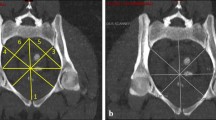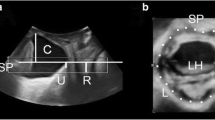Abstract
Purpose
The purpose of this study was to correlate MR pelvimetric pelvic inlet measurements with mode of delivery and neonatal outcome in patients with suspected fetopelvic disproportion or breech presentation.
Methods
For this retrospective monocentric study, 237 consecutive MR pelvimetry reports (1999–2016) of pregnant women due to either suspected fetopelvic disproportion, pelvic deformation after trauma, or persistent breech presentation were retrieved from the radiologic database and matched with corresponding information from the obstetric database.
Results
Of 223 included women, 95 (42.6%) underwent planned cesarean section (pCS) and 128 (57.4%) underwent a trial of vaginal labour (TOL), of whom 93 (72.7%) delivered vaginally. Vaginal delivery was successful in 45 out of 64 (70.3%) cephalic cases and in 48 out of 64 (75.0%) breech cases. We found statistically significant differences in conjugata vera obstetrica (CV) and diameter transversalis (DT) between the groups TOL and pCS (CV: 12.5 ± 1.0 vs 12.1 ± 1.2 cm, p value 0.001; DT: 13.3 ± 0.9 vs 12.7 ± 0.9 cm, p value <0.001, respectively). However, there was no significant difference between successful VD and cesarean section after TOL (CV: 12.5 ± 0.9 vs 12.3 ± 1.1 cm, p value 0.194; DT: 13.4 ± 0.9 vs 13.2 ± 0.9 cm, p value 0.358, respectively).
Conclusions
In our cohort, MR pelvimetry was a useful tool for prepartal assessment of the female pelvis in the selection of TOL candidates. Yet, it does not seem to yield additional predictive value for women with a previous vaginal delivery.



Similar content being viewed by others
References
Stark DD, McCarthy SM, Filly RA, Parer JT, Hricak H, Callen PW (1985) Pelvimetry by magnetic resonance imaging. Am J Roentgenol 144(5):947–950
Kikuchi S, Saito K, Takahashi M, Ito K (2010) Temperature elevation in the fetus from electromagnetic exposure during magnetic resonance imaging. Phys Med Biol 55(8):2411–2426
Baker PN, Johnson IR, Harvey PR, Gowland PA, Mansfield P (1994) A 3-year follow-up of children imaged in utero with echo-planar magnetic resonance. Am J Obstet Gynecol 170(1 Pt 1):32–33
Patenaude Y, Pugash D, Lim K, Morin L, Diagnostic Imaging C, Lim K, Bly S, Butt K, Cargill Y, Davies G, Denis N, Hazlitt G, Morin L, Naud K, Ouellet A, Salem S, Society of Obstetricians and Gynaecologists of Canada (2014) Gynaecologists of, The use of magnetic resonance imaging in the obstetric patient. J Obstet Gynaecol Can 36(4):349–363
Strizek B, Jani JC, Mucyo E, De Keyzer F, Pauwels I, Ziane S, Mansbach AL, Deltenre P, Cos T, Cannie MM (2015) Safety of MR imaging at 1.5 T in fetuses: a retrospective case–control study of birth weights and the effects of acoustic noise. Radiology 275(2):530–537
van Loon AJ, Mantingh A, Thijn CJ, Mooyaart EL (1990) Pelvimetry by magnetic resonance imaging in breech presentation. Am J Obstet Gynecol 163(4 Pt 1):1256–1260
Wentz KU, Lehmann KJ, Wischnik A, Lange S, Suchalla R, Gronemeyer DH, Seibel RM (1994) Pelvimetry using various magnetic resonance tomography techniques vs. digital image enhancement radiography: accuracy, time requirement and energy exposure. Geburtshilfe Frauenheilkd 54(4):204–212
Ferguson JE 2nd, Sistrom CL (2000) Can fetal-pelvic disproportion be predicted. Clin Obstet Gynecol 43(2):247–264
Harper LM, Odibo AO, Stamilio DM, Macones GA (2013) Radiographic measures of the mid pelvis to predict cesarean delivery. Am J Obstet Gynecol 208(6):460 e1–460 e6
Korhonen U, Taipale P, Heinonen S (2015) Fetal pelvic index to predict cephalopelvic disproportion—a retrospective clinical cohort study. Acta Obstet Gynecol Scand 94(6):615–621
Berger R, Sawodny E, Bachmann G, Herrmann S, Kunzel W (1994) The prognostic value of magnetic resonance imaging for the management of breech delivery. Eur J Obstet Gynecol Reprod Biol 55(2):97–103
van Loon AJ, Mantingh A, Serlier EK, Kroon G, Mooyaart EL, Huisjes HJ (1997) Randomised controlled trial of magnetic-resonance pelvimetry in breech presentation at term. Lancet 350(9094):1799–1804
Sporri S, Thoeny HC, Raio L, Lachat R, Vock P, Schneider H (2002) MR imaging pelvimetry: a useful adjunct in the treatment of women at risk for dystocia? Am J Roentgenol 179(1):137–144
Fox LK, Huerta-Enochian GS, Hamlin JA, Katz VL (2004) The magnetic resonance imaging-based fetal-pelvic index: a pilot study in the community hospital. Am J Obstet Gynecol 190(6):1679–1685 (discussion 1685–8)
Stalberg K, Bodestedt A, Lyrenas S, Axelsson O (2006) A narrow pelvic outlet increases the risk for emergency cesarean section. Acta Obstet Gynecol Scand 85(7):821–824
Zaretsky MV, Alexander JM, McIntire DD, Hatab MR, Twickler DM, Leveno KJ (2005) Magnetic resonance imaging pelvimetry and the prediction of labor dystocia. Obstet Gynecol 106(5 Pt 1):919–926
Maharaj D (2010) Assessing cephalopelvic disproportion: back to the basics. Obstet Gynecol Surv 65(6):387–395
Jeyabalan A, Larkin RW, Landers DV (2005) Vaginal breech deliveries selected using computed tomographic pelvimetry may be associated with fewer adverse outcomes. J Matern Fetal Neonatal Med 17(6):381–385
Vistad I, Cvancarova M, Hustad BL, Henriksen T (2013) Vaginal breech delivery: results of a prospective registration study. BMC Pregnancy Childbirth 13:153
Korhonen U, Taipale P, Heinonen S (2013) Assessment of bony pelvis and vaginally assisted deliveries. ISRN Obstet Gynecol 2013:763782
Korhonen U, Taipale P, Heinonen S (2014) The diagnostic accuracy of pelvic measurements: threshold values and fetal size. Arch Gynecol Obstet 290(4):643–648
McMaster-Fay RA (2015) Managing the breech presentation at term: the place of pelvimetry. Aust N Z J Obstet Gynaecol 55(1):99
Walkinshaw SA (1997) Pelvimetry and breech delivery at term. Lancet 350(9094):1791–1792
Griffiths M (1998) Magnetic-resonance pelvimetry in breech presentation. Lancet 351(9106):912 (author reply 913)
Bisits A (2015) The value of imaging pelvimetry in the management of the breech presentation at term. Aust N Z J Obstet Gynaecol 55(1):99–100
Hannah ME, Hannah WJ, Hewson SA, Hodnett ED, Saigal S, Willan AR (2000) Planned caesarean section versus planned vaginal birth for breech presentation at term: a randomised multicentre trial. Term Breech Trial Collaborative Group. Lancet 356(9239):1375–1383
Annual reports of the Bavarian Institute for Quality Assurance (2015). http://www.baq-bayern.de/leistungsbereiche/gynaekologiegeburtshilfeneonatologie/161-geburtshilfe/geburtshilfe. Accessed 11 Jul 2016
Korhonen U, Solja R, Laitinen J, Heinonen S, Taipale P (2010) MR pelvimetry measurements, analysis of inter- and intra-observer variation. Eur J Radiol 75(2):e56–e61
Tsvieli O, Sergienko R, Sheiner E (2012) Risk factors and perinatal outcome of pregnancies complicated with cephalopelvic disproportion: a population-based study. Arch Gynecol Obstet 285(4):931–936
Parissenti TK, Hebisch G, Sell W, Staedele PE, Viereck V, Fehr MK (2016) Risk factors for emergency caesarean section in planned vaginal breech delivery. Arch Gynecol Obstet. doi:10.1007/s00404-016-4190-y
Vrouenraets FP, Roumen FJ, Dehing CJ, van den Akker ES, Aarts MJ, Scheve EJ (2005) Bishop score and risk of cesarean delivery after induction of labor in nulliparous women. Obstet Gynecol 105(4):690–697
Landon MB, Leindecker S, Spong CY, Hauth JC, Bloom S, Varner MW, Moawad AH, Caritis SN, Harper M, Wapner RJ, Sorokin Y, Miodovnik M, Carpenter M, Peaceman AM, O’Sullivan MJ, Sibai BM, Langer O, Thorp JM, Ramin SM, Mercer BM, Gabbe SG, National Institute of Child, N. Human Development Maternal-Fetal Medicine Units (2005) The MFMU Cesarean Registry: factors affecting the success of trial of labor after previous cesarean delivery. Am J Obstet Gynecol 193(3 Pt 2):1016–1023
Macharey G, Ulander VM, Heinonen S, Kostev K, Nuutila M, Vaisanen-Tommiska M (2015) Induction of labor in breech presentations at term: a retrospective observational study. Arch Gynecol Obstet 293(3):549–555
Acknowledgements
The authors thank Regina Schinner for her statistical assistance.
Author information
Authors and Affiliations
Corresponding author
Ethics declarations
Conflict of interest
The authors declare that they have no conflict of interest.
Rights and permissions
About this article
Cite this article
Franz, M., von Bismarck, A., Delius, M. et al. MR pelvimetry: prognosis for successful vaginal delivery in patients with suspected fetopelvic disproportion or breech presentation at term. Arch Gynecol Obstet 295, 351–359 (2017). https://doi.org/10.1007/s00404-016-4276-6
Received:
Accepted:
Published:
Issue Date:
DOI: https://doi.org/10.1007/s00404-016-4276-6




